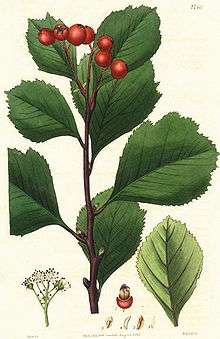Crataegus sanguinea
| Crataegus sanguinea | |
|---|---|
 | |
| Scientific classification | |
| Kingdom: | Plantae |
| (unranked): | Angiosperms |
| (unranked): | Eudicots |
| (unranked): | Rosids |
| Order: | Rosales |
| Family: | Rosaceae |
| Genus: | Crataegus |
| Series: | Sanguineae (Zabel ex C.K.Schneid) Rehder[1] |
| Species: | C. sanguinea |
| Binomial name | |
| Crataegus sanguinea Pall. | |
Crataegus sanguinea (common names Redhaw Hawthorn or Siberian hawthorn) is a species of hawthorn that is native to southern Siberia, Mongolia, and the extreme north of China. It is cultivated for its edible red berry-like fruit which actually is a pome. The fruit can be eaten raw or cooked. They can be used to make jam, jelly, and fruit preserves. They are also grown in gardens as ornamental plants. The flowers are small, white in color, and occur in clusters. The flowers give off a carrion smell.
The world's largest living individual of this species can be found in Volunteer Park, Seattle, Washington.[2]
References and external links
- Notes
- ↑ Phipps, J.B., O’Kennon, R.J., Lance, R.W. (2003). Hawthorns and medlars. Royal Horticultural Society, Cambridge, U.K.
- ↑ Arthur Lee Jacobson (2001). "Trees of Volunteer Park".
- Links
- Crataegus sanguinea information from Plants for a Future
| Wikimedia Commons has media related to Crataegus sanguinea. |
This article is issued from Wikipedia - version of the 10/13/2015. The text is available under the Creative Commons Attribution/Share Alike but additional terms may apply for the media files.